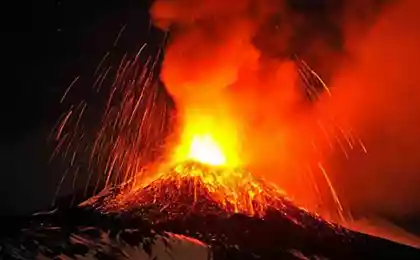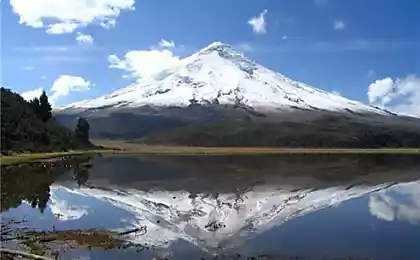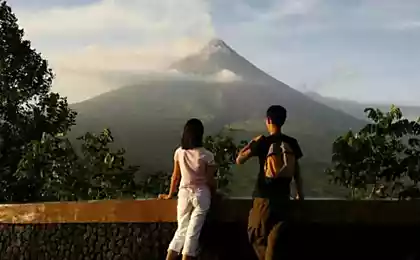2708
Eruption - view from space
A selection of photos taken from space.
Look, look like volcanoes from a great height.

Chaiten - active volcano in Chile
Altitude - 1122 m. The caldera volcano is about 3 km in diameter at the bottom it has several crater lakes. The volcano has been active for years 9400-9500, until 2 May 2008 not to launch a major eruption, the eruption is about 30 km in altitude. May 6 lava reached the village, within a radius of 50 km were evacuated almost the entire population. (Photo: NASA):

Sarychev Peak, Russia
Sarychev Peak - acting stratovolcano on the island of Matua Greater Kurile chain; one of the most active volcanoes in the Kuril Islands. The early stage of the eruption in 2009 was recorded on June 12 with the International Space Station. (Photo: NASA):
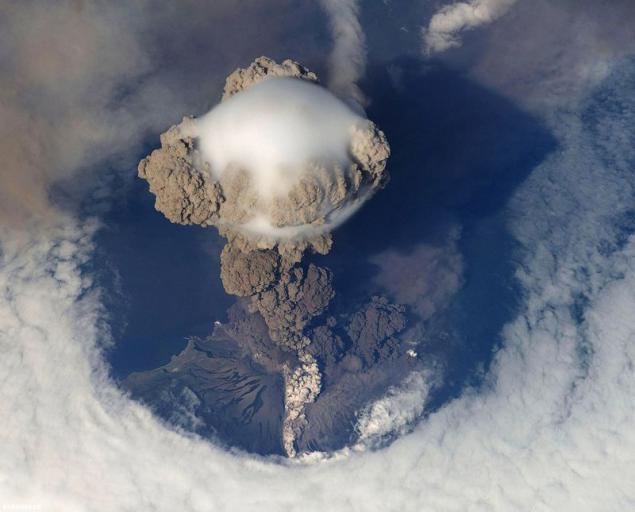
Kluchevskoy, Russia
Kluchevskoy (Klyuchevskoy volcano) - acting stratovolcano on the east of Kamchatka. With a height of 4,850 m, is the highest active volcano in Eurasia. Age eruption about 7000 years. (Photo: NASA):

Volcano Kluchevskoy. Also see the article "Volcanoes of Kamchatka". (Photo: NASA):

Pavlov Volcano, Alaska
Pavlov Volcano - active stratovolcano at the southern tip of the Alaska Peninsula. The diameter of the volcano is about 7 km. Is one of the most active volcanoes in Alaska, to his credit more than 40 historic eruptions. The last strong eruption was in 2013. (Photo: NASA | ISS Crew Earth Observations):

Puyehue, Chile
Puyehue - active volcano in southern Chile. Altitude peaks - 2236 m. June 4, 2011 in the area of the volcano, there were several small aftershocks, and the evening began erupting. Above the volcano Puyehue rose a huge column of smoke and ash. Volcanic ash cloud is moving in the direction of the wind Argentina. According to the National Service of Geology and Mining of the country, the volcano threw a column of ash up to 10 km. (Photo: NASA | GSFC | Jeff Schmaltz | MODIS Land Rapid Response Team):

Eruption of Eyjafjallajökull, Iceland
Volcanic eruption near the Eyjafjallajökull glacier in Iceland began on the night 20/21 March 2010. The main consequence of the eruption became ejection of volcanic ash cloud that disrupted air traffic in Northern Europe. (Photo: NASA | GSFC | Jeff Schmaltz | MODIS Land Rapid Response Team):

Volcano Nyiragongo, Congo
Since 1882 there have been 34 eruptions; at the same time it also happens that volcanic activity continuously lasted for many years. The main crater is 250 meters deep and 2 km wide; there is sometimes formed lava lake. One of the most violent eruptions Nyiragongo occurred in 1977; then flows from the fire killed several hundred people. (Photo: NASA):

Shin Moedake volcano, Japan
Following the massive earthquake in Japan volcano awoke Shin Moedake. It is located in the south-west of the country - on the island of Kyushu. The volcano threw up into the sky a pile of stones, and over the mountain formed a giant cloud of ash. (Photo: NASA | Jeff Schmaltz | MODIS Rapid Response Team):

Mount Merapi, Indonesia
Merapi - the largest active volcano in Indonesia, located on the island of Java near the city of Yogyakarta. The height of 2914 meters. Large eruptions occur on average every 7 years. One of the most devastating eruptions recorded in 1673, when it was destroyed several cities and many villages at the foot of the volcano .. (Photo by NASA):

Api volcano, Indonesia
Api - one of the most active volcanoes in Indonesia on the island of Sangeang. The height of the volcano - 1949 meters. (Photo: NASA):

Mount Etna, Italy
Etna - acting stratovolcano located on the east coast of Sicily. This is the highest active volcano in Europe. Now the height of Mount Etna is 3329 meters above sea level. Etna - the largest active volcano in Italy, surpassing its nearest "rival" Vesuvius more than 2, 5 times. According to various sources, Etna has between 200 and 400 lateral volcanic craters. On average, every three months, then one, then another crater spewed lava. Also see the article "Sicily and Mount Etna." (Photo: NASA):
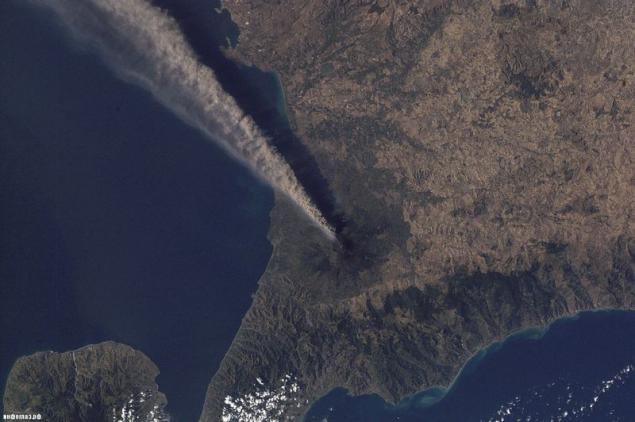
Manam Volcano, Papua - New Guinea
Big Manam volcano eruption occurred in the morning on January 12 to the north of New Guinea. Volcanologists reported that satellite images height of ash emissions up to 14 kilometers. (Photo: NASA | Jesse Allen):

Source: loveopium.ru
Look, look like volcanoes from a great height.

Chaiten - active volcano in Chile
Altitude - 1122 m. The caldera volcano is about 3 km in diameter at the bottom it has several crater lakes. The volcano has been active for years 9400-9500, until 2 May 2008 not to launch a major eruption, the eruption is about 30 km in altitude. May 6 lava reached the village, within a radius of 50 km were evacuated almost the entire population. (Photo: NASA):

Sarychev Peak, Russia
Sarychev Peak - acting stratovolcano on the island of Matua Greater Kurile chain; one of the most active volcanoes in the Kuril Islands. The early stage of the eruption in 2009 was recorded on June 12 with the International Space Station. (Photo: NASA):

Kluchevskoy, Russia
Kluchevskoy (Klyuchevskoy volcano) - acting stratovolcano on the east of Kamchatka. With a height of 4,850 m, is the highest active volcano in Eurasia. Age eruption about 7000 years. (Photo: NASA):

Volcano Kluchevskoy. Also see the article "Volcanoes of Kamchatka". (Photo: NASA):

Pavlov Volcano, Alaska
Pavlov Volcano - active stratovolcano at the southern tip of the Alaska Peninsula. The diameter of the volcano is about 7 km. Is one of the most active volcanoes in Alaska, to his credit more than 40 historic eruptions. The last strong eruption was in 2013. (Photo: NASA | ISS Crew Earth Observations):

Puyehue, Chile
Puyehue - active volcano in southern Chile. Altitude peaks - 2236 m. June 4, 2011 in the area of the volcano, there were several small aftershocks, and the evening began erupting. Above the volcano Puyehue rose a huge column of smoke and ash. Volcanic ash cloud is moving in the direction of the wind Argentina. According to the National Service of Geology and Mining of the country, the volcano threw a column of ash up to 10 km. (Photo: NASA | GSFC | Jeff Schmaltz | MODIS Land Rapid Response Team):

Eruption of Eyjafjallajökull, Iceland
Volcanic eruption near the Eyjafjallajökull glacier in Iceland began on the night 20/21 March 2010. The main consequence of the eruption became ejection of volcanic ash cloud that disrupted air traffic in Northern Europe. (Photo: NASA | GSFC | Jeff Schmaltz | MODIS Land Rapid Response Team):

Volcano Nyiragongo, Congo
Since 1882 there have been 34 eruptions; at the same time it also happens that volcanic activity continuously lasted for many years. The main crater is 250 meters deep and 2 km wide; there is sometimes formed lava lake. One of the most violent eruptions Nyiragongo occurred in 1977; then flows from the fire killed several hundred people. (Photo: NASA):

Shin Moedake volcano, Japan
Following the massive earthquake in Japan volcano awoke Shin Moedake. It is located in the south-west of the country - on the island of Kyushu. The volcano threw up into the sky a pile of stones, and over the mountain formed a giant cloud of ash. (Photo: NASA | Jeff Schmaltz | MODIS Rapid Response Team):

Mount Merapi, Indonesia
Merapi - the largest active volcano in Indonesia, located on the island of Java near the city of Yogyakarta. The height of 2914 meters. Large eruptions occur on average every 7 years. One of the most devastating eruptions recorded in 1673, when it was destroyed several cities and many villages at the foot of the volcano .. (Photo by NASA):

Api volcano, Indonesia
Api - one of the most active volcanoes in Indonesia on the island of Sangeang. The height of the volcano - 1949 meters. (Photo: NASA):

Mount Etna, Italy
Etna - acting stratovolcano located on the east coast of Sicily. This is the highest active volcano in Europe. Now the height of Mount Etna is 3329 meters above sea level. Etna - the largest active volcano in Italy, surpassing its nearest "rival" Vesuvius more than 2, 5 times. According to various sources, Etna has between 200 and 400 lateral volcanic craters. On average, every three months, then one, then another crater spewed lava. Also see the article "Sicily and Mount Etna." (Photo: NASA):

Manam Volcano, Papua - New Guinea
Big Manam volcano eruption occurred in the morning on January 12 to the north of New Guinea. Volcanologists reported that satellite images height of ash emissions up to 14 kilometers. (Photo: NASA | Jesse Allen):

Source: loveopium.ru

